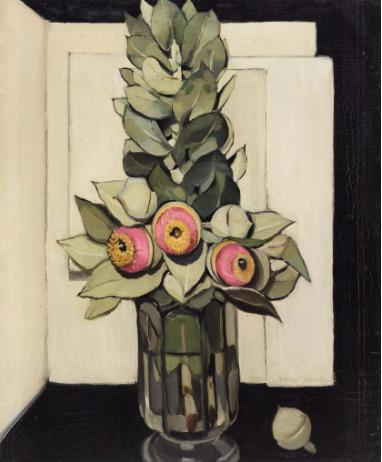First published in Field Guide, February 2018.
To find West Australian Gum Blossom, you need to navigate the Art Gallery of New South Wales’ cavernous Grecian lobby, walk past wall-length canvases by Charles Blackman and Brett Whiteley until you reach a smaller, sun-dappled room. In one corner, the painting, made in 1928 by the Sydney artist Margaret Preston, radiates a confidence that counters its proportions, given that it’s about as big as an iMac screen. Three flesh-pink blossoms peep out of their caps, or opercula, as if in dress rehearsal before blooming. Leaves point their tips upward; stiff enough to pluck and crack between your fingers. Their alien tones are achingly familiar. The grey-greens of the bush.
I haven’t always been a native plant enthusiast. In Western Australia, where I grew up, gumnuts, those bell-shaped fruit that Perth schoolkids liked to refer to as honkey nuts, pooled at the foot of Eucalypts, ready to be hurled at enemies during recess. Along with shadows of low-flying magpies and the prickle of late-afternoon sunburn, there was the sensation of skin and husk colliding with a painful thwack. Bottlebrush trees were a fixture of suburban backyards, their spindly, red flowers as common as the dishwashing implements they recalled in name and appearance. I didn’t care much for May Gibbs’ Snugglepot and Cuddlepie, which seemed to multiply like weeds, across every library I visited. A childhood spent reading Enid Blyton novels had convinced me of the romance of a garden full of heather, or a single, cabbage rose.
We’re trained to find beauty in the exotic: perfumes containing vetiver, hothouse orchids, Instagrams from far-flung places. That’s why it’s hard to believe all the ways in which the extraordinary — plants that cure ailments, flowers that resemble bottlebrush — resides in the well-worn landscape of our lives.
Like many artists of her generation, Preston spent her formative years in London, where she showed at the Royal Academy and made etchings that captured thatched cottages and English countryside. In 1919, she moved to Mosman, a Sydney suburb famous for glittering views of the harbour. The artist saw shapes and colours everywhere she looked. The sunburst petals of the firewheel, a sub-tropical tree that thrives in New South Wales and Queensland became Wheelflower (1925), a riot of greens and oranges that appear to throb and tumble out of the picture. The same year, Christmas Bells, those tear-shaped droplets that bloom as the temperature rises sparked a woodcut, nodding to her love of Japanese printmakers, as well as their long-held reverence for nature.
Later, Preston relocated to Berowra, near the Hawkesbury River and lived in a California bungalow, part of an attempt to recover from breast cancer. From a verandah overlooking kilometres of native bushland, she made the work that would define her career. Cobs of spiky banksia, blackened by bushfire. Stark eucalyptus trees done in dirt-brown and ochre. Preston immersed herself in Aboriginal culture; today, some of her motifs could be filed under appropriation. But to look at her impressions of waratahs, or proteas or gum blossoms, huddled together in a vase is to see them anew.
As she puts in a May 1935 interview with Art in Australia: “I’m trying with my cultivated knowledge to do away with all the imitativeness, the copying of the past great masters of the world. I am trying to find even one form which will express Australia in some way.”
We’re trained to find beauty in the exotic: perfumes containing vetiver, hothouse orchids, Instagrams from far-flung places. That’s why it’s hard to believe all the ways in which the extraordinary — plants that cure ailments, flowers that resemble bottlebrush — resides in the well-worn landscape of our lives. Each December, the trees in my concrete-heavy inner-Sydney neighbourhood sprout gum blossom, bright-orange starbursts that seem to secretly pre-empt the festive season. I admire them, like Preston would and wish that they’d stay around a little longer. I miss them when they’re gone.
